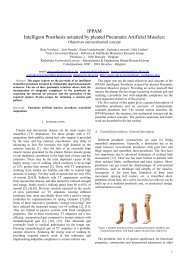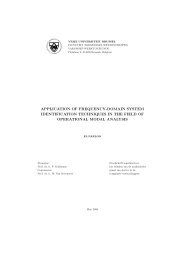VRIJE UNIVERSITEIT BRUSSEL Acoustics - the Dept. of ...
VRIJE UNIVERSITEIT BRUSSEL Acoustics - the Dept. of ...
VRIJE UNIVERSITEIT BRUSSEL Acoustics - the Dept. of ...
Create successful ePaper yourself
Turn your PDF publications into a flip-book with our unique Google optimized e-Paper software.
18 CHAPTER 1. FUNDAMENTAL CONCEPTS OF ACOUSTICSThis property is used in active noise control. E.g. : anti-noisetechnique in some headphones to reduce background noise as wellas for reducing noise generated by aircrafts in <strong>the</strong> cabin <strong>of</strong> <strong>the</strong>SAAB2000 plane.1.5.4 Types <strong>of</strong> soundBased on <strong>the</strong> frequency spectrum some types <strong>of</strong> sound can be distinguished :Pure tone : A sound characterized by only one frequency and can onlybe generated, approximatively, by a tone generatorMusical tone : (Figure 1.4-above) : It consists <strong>of</strong> a fundamental withovertones and are toge<strong>the</strong>r called partials. (Harmonics are partials).The number and <strong>the</strong> nature <strong>of</strong> <strong>the</strong> harmonics define <strong>the</strong> so-called ’tonecolor’.Chaotic or stochastic sound (Figure 1.4-middle) : (noise, hiss, etc.) Itcovers a wide frequency spectrum (where sounds with a specific frequencyand higher amplitudes than <strong>the</strong> o<strong>the</strong>r, are typical for <strong>the</strong> machineinvolved), think <strong>of</strong> ventilators, traffic noise, factory noise, jets,and so on. In acoustics a very detailed analysis will not be performed(cost) but an analysis in 1/1 octave band or 1/3 octave band. Theseare normalized. More detailed analysis e.g. 1/12 octave or even moredetailed are sometimes used in research.Impulse noise (Figure 1.4-below) : is a type <strong>of</strong> sound which is <strong>of</strong> veryshort duration, mostly generated by an impact.Sound can also be classified in o<strong>the</strong>r ways like considering <strong>the</strong> change <strong>of</strong>amplitude in function <strong>of</strong> time. This classification will be described in Part III<strong>of</strong> <strong>the</strong> text where <strong>the</strong> legislation regarding environmental noise is discussed.1.6 The acoustic intensity1.6.1 DefinitionA sound source delivers energy in <strong>the</strong> form <strong>of</strong> kinetic and potential energy,that is transported by <strong>the</strong> sound wave. Assume we have a ’free field’, i.e. noreflection possible. Consider a plane <strong>of</strong> 1 m 2 perpendicular to <strong>the</strong> directionin which we want to determine <strong>the</strong> intensity <strong>of</strong> a traveling plane wave.
















